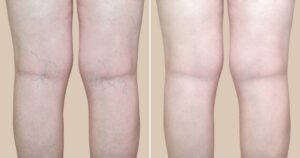Varicose veins are knobbly, twisted darkish-blue veins that appear on the legs. They develop due to faulty valves within the veins that allow blood to flow in one direction only.
Surgical treatment (phlebectomy) relieves symptoms like pain, swelling and itching in more than 80% of people. It also helps prevent recurrences.
Sclerotherapy
 During this procedure, your healthcare provider injects a unique chemical solution into varicose and spider veins. The solution irritates the inside of the vein, which causes it to close. The body then converts the affected vein into scar tissue and eventually removes it. Sclerotherapy usually takes about an hour or less to complete in a doctor’s office. You might need more than one treatment session. For professional varicose vein removal South Australia services, click here.
During this procedure, your healthcare provider injects a unique chemical solution into varicose and spider veins. The solution irritates the inside of the vein, which causes it to close. The body then converts the affected vein into scar tissue and eventually removes it. Sclerotherapy usually takes about an hour or less to complete in a doctor’s office. You might need more than one treatment session. For professional varicose vein removal South Australia services, click here.
Varicose veins develop when one-way valves in your veins stop working properly, causing blood to pool in the vessels. This can cause the veins to swell and twist, forming the bumpy appearance of varicose veins. Varicose veins are more common in women and older people. The condition is also more likely to run in families.
Before sclerotherapy, you might need to have an ultrasound test of your veins. This is to ensure that the treatment is proper for you. You should not have sclerotherapy if you are pregnant or have an underlying blood clotting disorder. It is also not a good choice if you have extensive varicose veins or are prone to developing them.
In some cases, health insurance companies will cover sclerotherapy for medical symptoms related to varicose veins. However, it’s not covered if the treatment is done solely for cosmetic reasons. You should always discuss any concerns with your insurance company before treatment.
After sclerotherapy, you might have redness, swelling, warmth or itching at the injection site for a few days or weeks. You might also have tiny blood vessels that develop at the treatment site and then fade over a few months. You should wear compression socks or stockings during the day, except when showering or sleeping, and take acetaminophen-based pain medicine if needed.
If sclerotherapy doesn’t help reduce your symptoms, your doctor may recommend surgery to treat your varicose veins. Several surgical methods exist, including phlebectomy, in which the surgeon makes minor cuts to remove affected varicose and spider veins. Another option is endovenous ablation, in which heat or glue seals the varicose vein from the inside and stops blood flow. For professional varicose vein removal South Australia services, click here.
Laser Treatment
Varicose veins are knobbly, twisted darkish-blue blood vessels near the surface of your skin. They cause health problems like aching, heavy legs, cramping and swelling.
They occur when faulty valves within your veins fail to allow blood to flow correctly. The weakened valves allow blood to pool, leading to these bulging, swollen and twisted veins forming. Varicose veins can affect both women and men but tend to occur more in older people. Some people have a family history of the condition. Still, it is also thought that changes in your hormone levels during puberty, pregnancy, breastfeeding and menopause can contribute to their development.
A variety of treatments are available to treat varicose and spider veins. These include sclerotherapy and laser treatment. Both options are non-invasive. In sclerotherapy, the doctor injects a chemical into the vein, which causes the walls to close up (sclerose). Blood flow into the vein is eliminated, and the affected area eventually fades away. The treatment takes about 15 to 30 minutes. You may feel slightly burning during the procedure, but it fades quickly. You may need several sclerotherapy sessions, usually three to six weeks apart. Some bruising may occur, but this is not typically serious and soon disappears, leaving you with healthier-looking legs.
Laser treatment is an alternative to sclerotherapy and is used to remove spider veins, small varicose veins and rosacea. The abnormal blood vessels absorb a high-intensity green laser light, which heats them and closes them off. The treated vessels then collapse and are absorbed by your body. After the treatment, you should wear compression stockings and keep your legs elevated as much as possible for a few days. You should be able to resume normal activities immediately after the treatment. Still, avoiding hot showers and saunas is best, as this will encourage the blood vessels to dilate.
In some cases, varicose veins can be removed surgically. This involves making numerous small incisions (cuts) rather than one large amount in the groin or behind the knee. The surgeon will then use a unique hook to remove the varicose vein.
Vascular Surgery
Varicose veins are knobbly, twisted and darkish blue in appearance. They are caused by faulty valves within the veins that allow blood to pool, causing them to become enlarged. Varicose veins can be treated with sclerotherapy or surgery.
Sclerotherapy is the clinical process whereby a small injection of a specialised solution is used to obliterate these ugly, troublesome veins. This is a fast, pain-free treatment with results that last for years. For professional varicose vein removal South Australia services, click here.